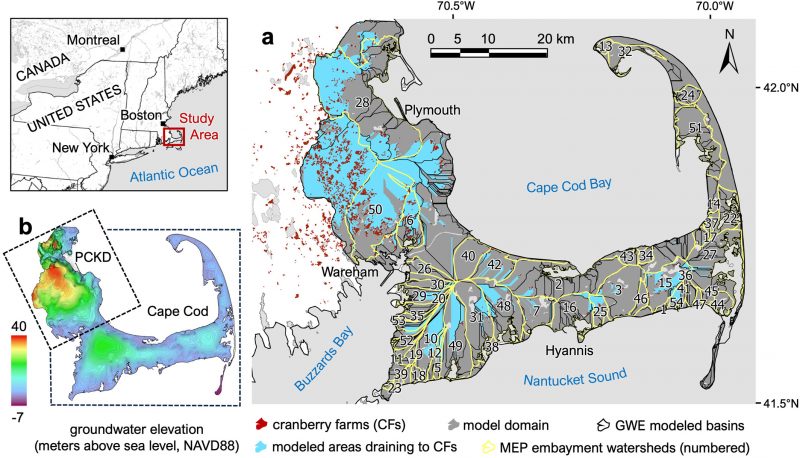Researchers Find that Cranberry Farm Restoration Efforts Can Have Positive Effects on Downstream Water Quality
Before they became areas for crop production, many cranberry farms around Southeastern Massachusetts were natural wetlands. Natural wetlands host a more diverse ecosystem of plants and animals than occur on a cranberry farm. According to an analysis by a team of researchers including the Coalition’s VP of Science Rachel Jakuba and board member Chris Neill, restoring select cranberry farms to natural wetlands may substantially reduce nitrogen pollution to coastal bays and improve water quality.
By studying groundwater models, researchers concluded that targeted wetland restoration can reduce these nutrient overloads flowing through these landscapes. The findings, published September 18 in the journal JGR Geobiosciences, offer guidance for improving the efficiency of restoration programs.
Southeastern Massachusetts is densely covered with groundwater-fed wetlands that occupy glacially formed kettle-hole depressions and coastal valleys. Many of these wetlands have been modified for cranberry farming, which has decreased the extent of natural wetlands and limited their capacity to remove nitrogen.
“In Southeastern Massachusetts, nitrogen travels primarily through groundwater rather than overland flow,” says Neill, one of the study’s co-authors. “To address this, we used U.S. Geological Survey groundwater models to develop a tool to rapidly estimate contributing areas and identify which cranberry farms receive the greatest nitrogen loads from upstream sources.”
The team adapted a U.S. Geological Survey groundwater model to estimate how much nitrogen was flowing into and out of 984 cranberry farms. Then, they looked at the potential Nitrogen reduction from the retirement and restoration of farms. “This work clearly shows that some cranberry farms act as collection points of groundwater from surrounding areas. Some of these areas have a high density of septic systems that add nitrogen to groundwater. Restoration of bogs that collect high nitrogen groundwater will both have a high benefit for nitrogen reduction, in addition to the ecosystem benefits of restoring bogs to natural wetlands,” says Jakuba.
The model serves as a screening tool to identify farms with high potential to reduce watershed nitrogen, but more field monitoring is needed to refine estimates in former cranberry wetlands.
To read the published article, go here.

Although many of the embayments studied were on the South Shore and Cape Cod, the findings are applicable to similar glacially-formed topographies near the coast.